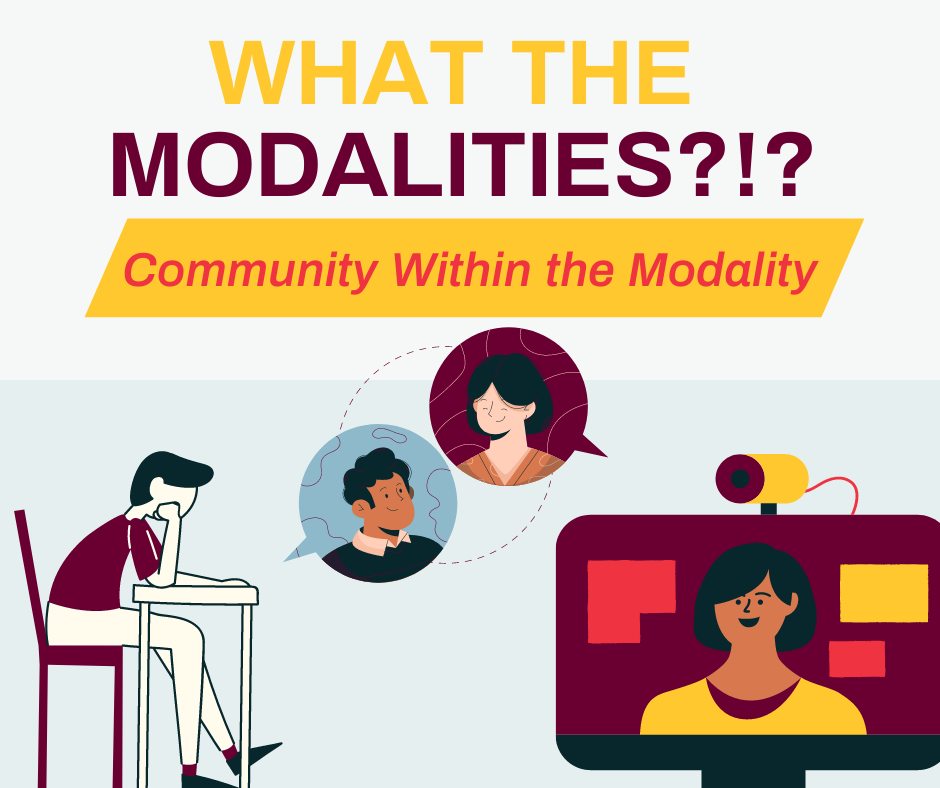“We know our disciplines well, but now it is time to consider how to translate our practices to the many “spaces” we find ourselves (and our learners) in so that we can foster learning and prepare our students for a competitive, global workforce” (MTMC, Module 1).
Whether you are a well-practiced instructor looking to refine your craft, brand new to teaching and wondering where to begin, or anywhere in between, keep reading and know that you are not alone. We can all appreciate the learning curve (and accompanied discomfort) associated with teaching and learning in these new, perhaps unfamiliar, modern classrooms.
To support CMU instructors on your continued journey, over the next 3 weeks, we will explore what effective teaching and learning looks like in these new and diverse settings as we share practical information and valuable insights from our Multi-Modal Teaching Methods Certification (or MTMC) faculty development opportunity.
Community Within the Modality
During a two-year journey across the US, journalist Kristina Rizga interviewed veteran educators in search of an answer to this question, “What is Good Teaching?” While Rizga’s research focused on K-12 learning in America, her powerful conclusion undoubtedly applies to higher ed, here at CMU, and globally. “The most effective teaching tools directly address the fundamental human needs of a diverse classroom community—traits like empathy, kindness, and a deep respect for the lives and interests of individual students” (Rizga, 2020).
In the typical collegiate course, a group of individuals with a common learning goal is, by definition: a community inherently positioned to support learning. However, alone, this group of individuals, with their collective goal is not enough to produce learning. The missing piece? Community within that community, or social presence. The Community of Inquiry (COI) educational framework describes social presence as one of three “crucial prerequisites for a successful higher educational experience” (along with critical thinking, cognitive activity, and effective management of the instructional experience) (Garrison et al., 2000, p. 87). Defined as “the ability of participants in a community to project themselves, socially and emotionally, as real people through a medium of communication,” social presence builds cohesion and connections between people in the learning community through communication, cognitive and emotional investment, and mutual respect in any modality or learning space (Garrison et al., 2000, p.88).
In the context of the classroom community, social presence directly impacts the student experience and their learning. Richardson and Swan (2003) determined “that students who felt that they had a lot of social presence with their instructor also perceived that they learned more from the course than students with very low social presence with their instructor, indicating that there is a relationship between social presence and perceived learning” (p. 74).
Social Presence in Multiple Learning Modalities: Social presence (the presence and extent of social connections) is a vital part of the learning process; this only became clearer amid the social isolation associated with the Covid-19 pandemic. As we are presented with more opportunities to teach using new(er) instructional modalities, we must also identify methods to create social presence and build community in these class(room) spaces. How? The traits that Rigza (2020) identified earlier, “empathy, kindness, and respect,” are the pillars upon which social presence can be built in our classrooms. These elements remain foundational requirements for establishing human connections and relationships regardless of your physical learning space. As the demands of modern teaching continue to increase, precisely how one might build community through social presence might seem abstract, foreign, and likely overwhelming. However, simple practices, such as smiling and greeting students wherever they are, making eye contact in class, and looking directly into the web camera for remote learners, will go a long way toward this goal.
What’s next? Enroll in the MTMC training shell, check next week’s CIS newsletter, or send us an email to learn more strategies for building and maintaining social presence and connecting learners in diverse learning spaces (face-to-face, online, or both).
References:
Rigza, K. (2020). What is good teaching? The Atlantic. Retrieved from https://www.theatlantic.com/education/archive/2020/09/teaching-what-good-teaching/616352/
Garrison, R.D., Anderson, T., & Archer, W. (2000). Critical inquiry in a text-based environment: Computer conferencing in higher education. The Internet and Higher Education, 2(2-3), 87-105. Retrieved from https://cde.athabascau.ca/coi_site/documents/Garrison_Anderson_Archer_Critical_Inquiry_model.pdf
Richardson, J. & Swan, K. (2003). Examining social presence in online courses in relation to students’ perceived learning and satisfaction. Journal of Asynchronous Learning Networks, 7, 68-88.


1 thought on “What the Modalities?!? C …”
Comments are closed.